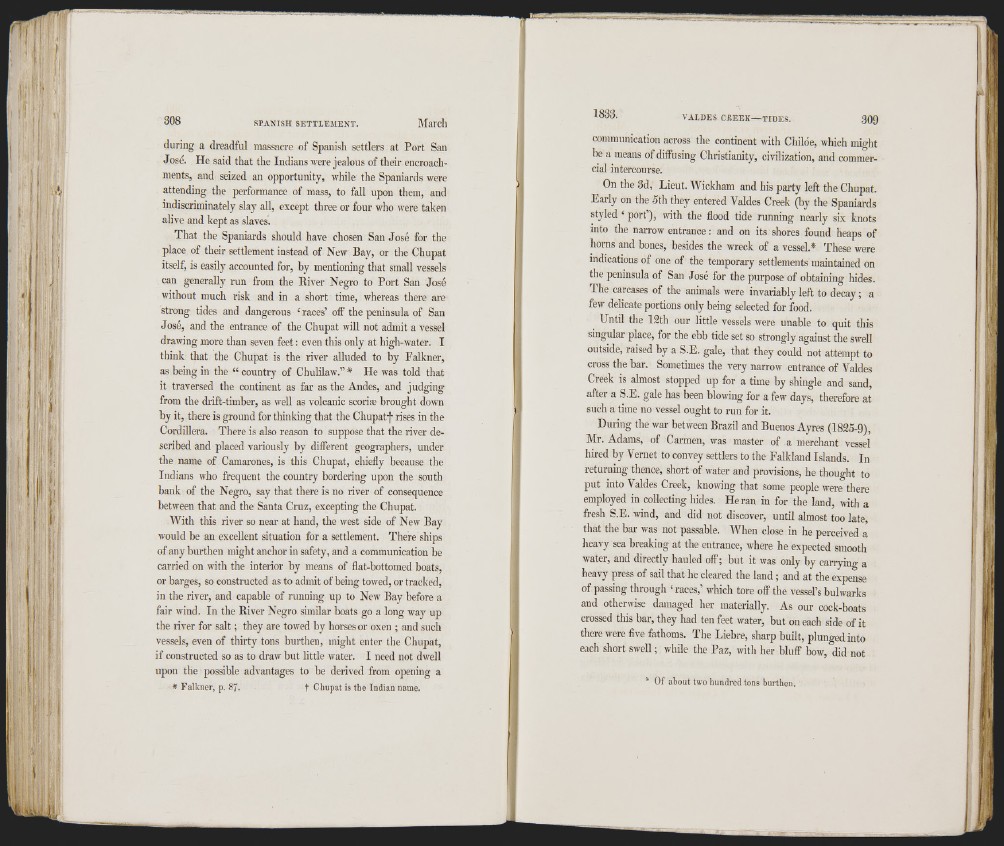
, • ri'
during a dreadful massacre of Spanish settlers at Port San
José. He said that the Indians were jealous of their encroachments,
and seized an opportunity, while the Spaniards were
attending the performance of mass, to fall upon them, and
indiscriminately slay all, except three or four who were taken
alive and kept as slaves.
That the Spaniards should have chosen San José for the
place of their settlement instead of New Bay, or the Chupat
itself, is easily accounted for, by mentioning that small vessels
can generally run from the Iliver Negro to Port San José
without much risk and in a short time, whereas there are
strong tides and dangerous ‘ races’ off the peninsula of San
José, and the entrance of the Chupat will not admit a vessel
drawing more than seven feet ; even this only at high-water. I
think that the Chupat is the river alluded to by Falkner,
as being in the “ country of Chulilaw.” * He was told that
it traversed the continent as far as the Andes, and judging
from the drift-timber, as well as volcanic scoriae brought down
hy it, there is ground for thinking that the Chupat-f- rises in the
Cordillera. There is also reason to suppose that the river described
and placed variously by different geographers, under
the name of Camarones, is this Chupat, chiefly because the
Indians who frequent the country bordering upon the south
bank of the Negro, say that there is no river of consequence
between that and the Santa Cruz, excepting the Chupat.
With this river so near at hand, the west side of New Bay
would be an excellent situation for a settlement. There ships
of any burthen might anchor in safety, and a communication be
carried on with the interior by means of flat-bottomed boats,
or barges, so constructed as to admit of being towed, or tracked,
in the river, and capable of running up to New Bay before a
fair wind. In the River Negro similar hoats go a long way up
the river for salt ; they are towed hy horses or oxen ; and such
vessels, even of thirty tons burthen, might enter tlie Chupat,
if constructed so as to draw hut little water. I need not dwell
upon the possible advantages to he derived from ojiening a
* Falkner, p. 87. t Chupat is the Indian name.
1833.
communication across the continent with Chiloe, which might
he a means of diffusing Christianity, civilization, and commercial
intercourse.
On the 3d, Lieut. Wickham and his party left the Chupat.
Larly on the 5th they entered Valdes Creek (by the Spaniards
styled ‘ port’), with the flood tide running nearly six knots
into the narrow entrance ; and on its shores found heaps of
horns and bones, besides the wreck of a vessel.* These were
indications of one of the temporary settlements maintained on
the peninsula of San Jose for the purpose of obtaining hides.
The carcases of the animals were invariably left to decay; a
few delicate portions only being selected for food.
Until the 12th our little vessels were unable to quit this
singular place, for the ebb tide set so strongly against the swell
outside, raised by a S.L. gale, that they could not attempt to
cross the bar. Sometimes the very narrow entrance of Valdes
Creek is almost stopped up for a time by shingle and sand,
after a S.L. gale has been blowing for a few days, therefore at
such a time no vessel ought to run for it.
During the war between Brazil and Buenos Ayres (1825-9),
Mr. Adams, of Carmen, was master of a merchant vessel
hired hy Vernet to convey settlers to the Falkland Islands. In
returning thence, short of water and provisions, he thought to
put into Valdes Creek, knoiving that some people were there
employed in collecting hides. He ran in for the land, with a
fresh S.L. wind, and did not discover, until almost too late,
that the bar was not passable. When close in he perceived a
heavy sea breaking at the entrance, where he expected smooth
water, and directly hauled off; but it was only by carrying a
heavy press of sail that he cleared the land; and at the expeLe
of passing through ‘races,’ which tore off the vessel’s bulwarks
and otherwise damaged her materially. As our cock-boats
crossed this har, they had ten feet water, but on each side of it
there were five fathoms. The Liebre, sharp built, plunged into
each short swell; while the Paz, witli her bluff bow, did not
* Of about two hundred tons burthen.